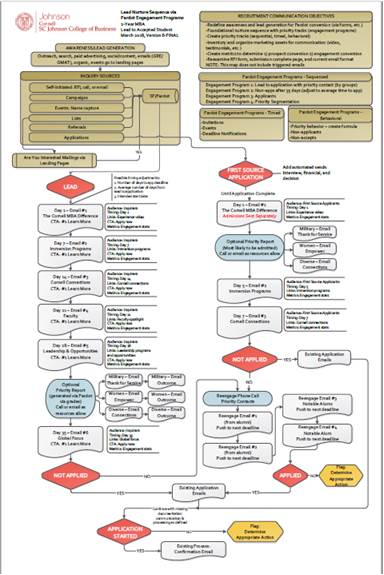Johnson Graduate School of Management at Cornell University
Find out how this competitive graduate school staked its claim in a small but saturated recruiting market – with demand generation support from Stamats.
16x

Improvement Nurture Campaign Application Completions
54%

Nurture Campaign Yield

In the rarified competitive world of top 15 (T15) graduate business schools, how does one school create brand preference among seemingly identical competitors? That was the question facing the Johnson Graduate School of Management at Cornell University, as it witnessed qualified candidates selecting competitive MBA programs.
Working with the Admissions and Marketing teams at the Johnson School, Stamats helped design a process that would lead prospective MBA students from early awareness to engagement and ultimately, brand preference.
To help the Johnson School engage prospects earlier, deepen that engagement overtime, and position the institution as the school of first choice, we divided our work into three highly coordinated phases.
Clarifying Ownership and Accountabilities
At Johnson, as at many schools, outreach was the responsibility of Marketing. The process of guiding prospects through the enrollment journey (and lead nurturing), however, was the responsibility of Admissions.
As is typical in this type of marketing vs. “sales” scenario, no one owned the entire process, resulting in a somewhat disjointed brand experience.
Stamats’ first task was to get both the Admissions and Marketing teams around the same table and agree upon key performance indicators, messaging, and process. This “meeting of the minds” is key to the demand generation process as is shares ownership and accountabilities.
Developing Targeted, Full-Cycle Messaging
Since the Johnson School has a solidly defined brand position, the key was to translate that position into a series of content “bites” that would appeal to prospects at various stages of their enrollment journey.
We began by building personae for each of our targets: females, veterans, diverse students, etc. Through an exercise we call communications sequence mapping, we were able to visualize the enrollment journey for each of our targets and then map content messages to each key touchpoint. Messages would be delivered based upon timing, conversion, or other activity (e.g., website page views).
An important piece of the plan was to extend the communications map beyond application, since most prospects for top tier MBA programs apply to several institutions. Additionally, we created a content stream for “first source” or stealth applicants, since those applicants would have never received our inquiry communications.
Once the maps were developed and approved, our team wrote and designed all the ads, landing pages, and emails. We then worked closely with the Johnson School staff to build the communications logic and enter all of the templates and messaging into their CRM, Slate.
By clearly defining the content needs at each touchpoint in the enrollment journey, we were able to create a plan that moved the prospect from initial awareness to brand preference.
Tracking KPIs and Improving Performance
The KPIs that were agreed upon by Admissions and Marketing tracked macro-conversions to indicate overall program success. The set of KPIs included:
- RFI (Request for Information) completion
- Application starts
- Application completes
- Acceptances
- Enrollments
Using Slate (with an interface to Cornell’s Peoplesoft SIS instance), we were able to track and attribute individual prospects from inquiry to enrollment.
At the same time, it was important for us to continually improve the performance of every aspect of the program, from ad content and placement to email headers. Monitoring micro-conversions (i.e., click rates, email opens, content engagement, etc.) allows us to continually refine our marketing in virtual real time.
The success of Stamats’ work with the Johnson School is borne out in both the dramatically improved site metrics and strong conversion rates.
- Those who started an application for a traditional MBA were 16 times more likely to complete that application.
- Overall, inquiries were 54% more likely to apply.
Why? The campaign increased engagement.
- Nurture stream visitors spent 50% more time on the site than non-nurture visitors.
- The average number of page views also increased by 24%.
-
The Challenge
In the rarified competitive world of top 15 (T15) graduate business schools, how does one school create brand preference among seemingly identical competitors? That was the question facing the Johnson Graduate School of Management at Cornell University, as it witnessed qualified candidates selecting competitive MBA programs.
Working with the Admissions and Marketing teams at the Johnson School, Stamats helped design a process that would lead prospective MBA students from early awareness to engagement and ultimately, brand preference.
-
The Project
To help the Johnson School engage prospects earlier, deepen that engagement overtime, and position the institution as the school of first choice, we divided our work into three highly coordinated phases.
Clarifying Ownership and Accountabilities
At Johnson, as at many schools, outreach was the responsibility of Marketing. The process of guiding prospects through the enrollment journey (and lead nurturing), however, was the responsibility of Admissions.
As is typical in this type of marketing vs. “sales” scenario, no one owned the entire process, resulting in a somewhat disjointed brand experience.
Stamats’ first task was to get both the Admissions and Marketing teams around the same table and agree upon key performance indicators, messaging, and process. This “meeting of the minds” is key to the demand generation process as is shares ownership and accountabilities.
Developing Targeted, Full-Cycle Messaging
Since the Johnson School has a solidly defined brand position, the key was to translate that position into a series of content “bites” that would appeal to prospects at various stages of their enrollment journey.
We began by building personae for each of our targets: females, veterans, diverse students, etc. Through an exercise we call communications sequence mapping, we were able to visualize the enrollment journey for each of our targets and then map content messages to each key touchpoint. Messages would be delivered based upon timing, conversion, or other activity (e.g., website page views).
An important piece of the plan was to extend the communications map beyond application, since most prospects for top tier MBA programs apply to several institutions. Additionally, we created a content stream for “first source” or stealth applicants, since those applicants would have never received our inquiry communications.
Once the maps were developed and approved, our team wrote and designed all the ads, landing pages, and emails. We then worked closely with the Johnson School staff to build the communications logic and enter all of the templates and messaging into their CRM, Slate.
By clearly defining the content needs at each touchpoint in the enrollment journey, we were able to create a plan that moved the prospect from initial awareness to brand preference.
Tracking KPIs and Improving Performance
The KPIs that were agreed upon by Admissions and Marketing tracked macro-conversions to indicate overall program success. The set of KPIs included:
- RFI (Request for Information) completion
- Application starts
- Application completes
- Acceptances
- Enrollments
Using Slate (with an interface to Cornell’s Peoplesoft SIS instance), we were able to track and attribute individual prospects from inquiry to enrollment.
At the same time, it was important for us to continually improve the performance of every aspect of the program, from ad content and placement to email headers. Monitoring micro-conversions (i.e., click rates, email opens, content engagement, etc.) allows us to continually refine our marketing in virtual real time.
-
The Results
The success of Stamats’ work with the Johnson School is borne out in both the dramatically improved site metrics and strong conversion rates.
- Those who started an application for a traditional MBA were 16 times more likely to complete that application.
- Overall, inquiries were 54% more likely to apply.
Why? The campaign increased engagement.
- Nurture stream visitors spent 50% more time on the site than non-nurture visitors.
- The average number of page views also increased by 24%.


